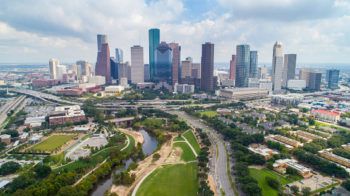Brazos Valley Air Quality Poor, Prof Says
Despite outside appearances on most days, the air quality over the Bryan-College Station area is poor, so much so that it likely fails federal ozone standards – particularly proposed new standards, says a Texas A&M University professor, who adds that it doesn’t take a Sherlock Holmes to pinpoint one of the causes: the Houston area.
Gunnar Schade, professor of atmospheric sciences and a specialist in air quality, says a study conducted locally in 2006-2007, but for which the results have just recently been fully analyzed and assessed, shows that ozone air then barely met federal guidelines as set by the EPA (Environmental Protection Agency). While not posing an immediate health risk, summertime ozone levels pose potential problems for persons with breathing issues such as asthma or other respiratory illnesses. Newer studies have found that even healthy adults are affected by ozone levels routinely observed in Brazos County in summer 2006.
The study was funded by the Texas Commission on Environmental Quality (TECQ).
Schade says the air quality may show little improvement over the next 10 years.
“Good air quality in the Brazos Valley is mostly a myth,” he stresses.
“The bottom line is that during much of the summer, we are getting either Houston’s bad air or old air with high ozone out of the north and northeast, as far away as Chicago,” Schade explains.
“Many petrochemical and industrial plants in the Houston area still strongly affect Houston air quality, and have for many decades, worsening air quality over what would be expected from car traffic only. While Houston’s air is much cleaner now than it has been in several decades, it still makes for a potent mix, and we live downwind of it.
“EPA reviews and adjusts air pollutant standards regularly – for ozone last in 2008 – and this means our air here may not meet the current federal ozone standards.”

During a large-scale air quality study in East Texas in 2006 that involved 200 researchers from multiple agencies and took about 18 months to complete, Schade and the research team monitored air quality at Lick Creek Park, located east of Highway 6 in College Station. The highest ozone readings exceeded 100 ppb (parts per billion), with 11 days exceeding 75 ppb, which is the current limit set in 2008.
“The EPA is in the process of revising the ozone standard further downward, meaning the local ozone levels would likely fail the new standards,” Schade explains, adding that the new acceptable levels will fall between 60 and 70 ppb.
He says the ozone in the Brazos Valley area is often affected in one of two ways: first, by high ozone background levels in a northerly or northeasterly flow (often air from the Great Lakes region), and second, by freshly produced high ozone in air coming from the southeast. These air flows from the greater Houston region reach the Brazos Valley area by late afternoon or evening in the spring and summer months.
Schade says it’s likely that the EPA will require monitor installations in the area to collect more data in the near future.
As for health risks?
“There have always been health risks,” he adds.
“While most people will probably not be severely affected, the rule of thumb is that 10 percent of the general population is more or less sensitive, some without even knowing it, while others must keep an inhaler close at hand,” he notes.
“What all of this means is that living far away from Houston does not guarantee good air. Our knowledge of air quality effects has improved and the rules are changing accordingly. What was once acceptable air quality no longer is. And there is really not much we can do about it because we don’t make much of our own ozone – it comes from somewhere else.”
Schade plans to submit a publication on the research soon.
Media contact: Keith Randall, Texas A&M News and Information Services.





